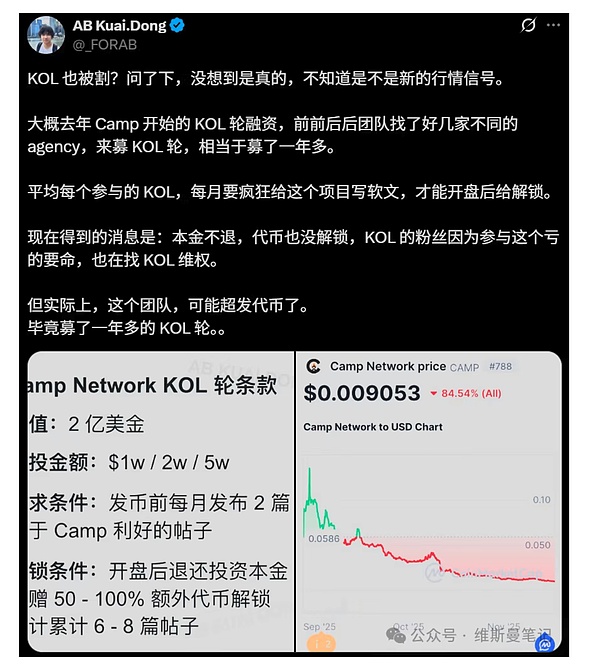
Today I will write something off-topic, and by the way, I would like to thank the big V in the circle for their recent reposts.
I personally have an X account, but I have no plans to seriously operate on X at the moment.This is not a spur-of-the-moment decision, but a choice after repeated weighing.Today’s article will start from here, and then get to the main topic.I have been doing this self-media for several years. The readers are basically old friends who have been through several bulls and bears together. Most of the fans who follow me have watched my content for many years, so I don’t beat around the bush and talk about it from the bottom of my heart.
Why don’t I run X
To explain this problem, we must first talk about the monetization logic of Web3 KOL.
From the perspective of an individual KOL, it is actually very difficult to monetize “only by relying on the content itself”.From what I know and see so far, there are probably only a handful of people like Liu Jiaolian who can survive basically relying on pure content payment.
In my eyes, this circle can be roughly divided into two types of people:
1. Coin speculators
2. Web3 users
The first type of currency speculation users will not pay for “content”, but only for “traffic”.A typical case is to publish a few hundred points of return rate on X or the square, and then teach you how to speculate.I don’t think this type of content is paid for content. In essence, it uses screenshots of profitability to attract traffic, and then converts and harvests it.
The second category is Web3 users, who may be practitioners/entrepreneurs, or they may be people who really have complete ideas about Web3 and are willing to think deeply.Such users do pay for premium content, but the proportion is very small.In the entire currency circle, excluding all kinds of brush volume, I subjectively estimate that this group of people may be less than 20%.
More importantly:
This type of people have one thing in common – they think for themselves.
The more people think for themselves, the harder it will be for you to use simple marketing techniques to persuade them to spend money. This is much more difficult than “lulling a group of people who just want to speculate in coins into a paid group.”Therefore, if you want to do “content monetization” for X’s large-scale traffic, it is not very attractive to me.
The most common method of monetization for KOLs: promotion
In addition to payment for the content itself, the most common way for KOLs to monetize their content is through various promotions.
From a single soft advertisement, tweeting and promoting goods, to the so-called KOL agency joint promotion, they are essentially serving Party A.In most industries, this business logic is reasonable and legal.But this is the currency circle—a place where “fraud” can be packaged as “narrative.”
I personally don’t want to take too many uncertain legal and moral risks for money, and I don’t want to end up “living in a foreign country” because of a few promotions.So in recent years, I have basically not participated in this kind of promotion.To be more realistic, this kind of promotion is not guaranteed to make money, and the probability of making mistakes and losing money is not small.

What’s more, now Web3 KOL has been completely industrialized.
There are already several MCN organizations mass-producing Web3 KOL:
Send content in batches from X, Xiaohongshu, and Douyin to divert traffic, collect people into private domains, and then uniformly transform them—some sell courses, some use rebates to bring orders, and some directly induce people to buy coins.My self-media does not have any of these operations, so I do not consider myself a “KOL”.
Experience 1: To make money, you need to use “reverse thinking”
I am half a product manager. During my work and cooperation, I have seen a very common pattern:
The starting point for most people is:
“I have a good idea → turn the idea into a product or service → then find users, sell it, and expand it.” From the perspective of “product methodology”, this is certainly worth talking about.But if you only look at it from the perspective of “making money”, I prefer to think in reverse:
Think clearly first: Whose money do I want to make?
→ Then design products and services around these “people who are willing to pay”,
Instead of building something first and then looking for users everywhere.Among the projects I have collaborated with, some have failed and some have made money.
-
Last year, I worked on an RWA-related business with Yifang team, and their logic was very clear: they already had a clear buyer for the assets in their hands.
-
What buyers need is a compliant and legal RWA solution
-
Therefore, it was deduced in reverse: a RWA project needs to be done to meet these “already existing needs”
-
This is a standard “buyer first, product later” route.
And I see more projects like this:
-
There is no clear buyer profile and no real demand
-
Constantly chasing market hot spots, changing stories, changing narratives, and restarting hype
-
I hope to catch some “fish that slipped through the net” from the public traffic in the currency circle.
In my opinion, there is great uncertainty here.
The probability of project failure has been more than half from the beginning.Let’s take another specific case and talk about “how reverse thinking can help make money.”
-
I had a content-related cooperation with a friend before, and I was responsible for providing a batch of high-quality content.
-
And his logic is very simple and realistic: he has a batch of real Solana community resources (both at home and abroad)
-
Various community mods have been opened and you can post content in groups without getting kicked.
-
I am responsible for outputting a batch of high-quality content and putting it into these real communities.
-
Naturally, people in the community will be attracted by the content and take the initiative to chat privately.
-
He then introduces these people into new communities for secondary precipitation.
-
When the meme market breaks out, insert a CA into this new group that has been “screened through one round” and let everyone rush to it.
It turns out that he did make a lot of money in this pump.fun craze.
The key to this case is:
-
He has buyers first: a group of real and accessible user communities
-
Come to me again to provide services: high-quality content suitable for these users
-
Only in the end can we talk about monetization
Why do I think “making money by thinking backwards” is more likely to succeed?
This brings us to the second experience.
Lesson 2: Think clearly about “sunk costs” first
In the field of making money, “ideas” are the least valuable assets.
Everyone has their own ideas and paths for making money.If you can think of an idea, others may also think of it, or even think of it earlier and more maturely.So the question is: when everyone has an idea, how can we break the situation?
The answer is: execution.
Ideas are always subject to execution.There are many people with ideas, but only one out of ten has an idea and actually does it.
The vast majority of people stop at “seeing how others make money” and shrink back when it comes to doing it themselves.Take a more universal example – dining.
Many people have thought about similar routes:
“Whenever I have some start-up capital, I will open a store by myself.” But when it comes to opening a store, he often chooses a safer way: franchising.
It is hoped that with the help of external forces, the execution cost of starting from scratch can be omitted.The result is:
He completely handed over the most important supply chain capabilities and pricing power to others.
In the end, it became the kind of “joining and cheating stories” that we often see in the news.This example illustrates two things:
-
Execution is scarce
-
Execution ability is essentially limited by “cost”
Why do so many people prefer to pay a franchise fee rather than start from scratch?
-
Because execution requires costs: learning costs (such as understanding the supply chain)
-
Communication costs (connecting with suppliers, managing employees, and fighting with the property management)
-
Cost of time and energy (you have to actually stay in the store instead of being a hands-off shopkeeper)
I call all of these: sunk costs.
And execution ability is “stuck” by sunk costs.So, when you really plan to start a business and do something, I believe your starting point is mostly to make money.Before taking action, there is a very important order:
-
What do I need to pay to prioritize sunk cost assessment?Time, money, connections, energy, reputation, costs in various dimensions.Even if I lose all my money, make a mistake, or fail, can I bear these costs?
-
If you think the sunk cost is acceptable, then consider: With your current resources, capabilities, and manpower, do you have the chance to do this well?
-
The last thing is: In this set of business logic, can you add your own “creativity and ideas” to make differentiation.
If the order is wrong, it can easily become:
Idea → Enthusiasm rises → Start executing → Discover halfway that the cost cannot be afforded → Give up halfway
Not only did he not make any money, he also put himself in a dilemma.
Conclusion
If the currency circle is regarded as a huge casino, then what most people discuss every day is “how to play cards.”
-
Few people seriously think about: Who runs this casino?
-
Who designed the chips?
-
Who wrote the rules?
-
And am I a player or a bargaining chip?
Not operating X, not taking the initiative to play traffic games, is just a choice for me:
I would rather spend my time on projects that serve real needs and deal with people who are willing to think for themselves and pay for value.If you happen to be thinking about how to make money, start a business, and transform in this industry,
-
Then I hope you remember at least two things: find a “buyer” first, and then make a product.
-
Don’t expect to catch “fish that slip through the net” from public domain traffic. That is a game for KOLs and institutions, not ordinary people.Calculate the “sunk costs” first, and then talk about execution and creativity.
If the cost is unaffordable, no matter how beautiful the idea is, it is just an illusion.As for how to find your own group of “buyers” and how to evaluate the sunk costs you can afford,
Maybe I will write more slowly if I have the opportunity in the future.








